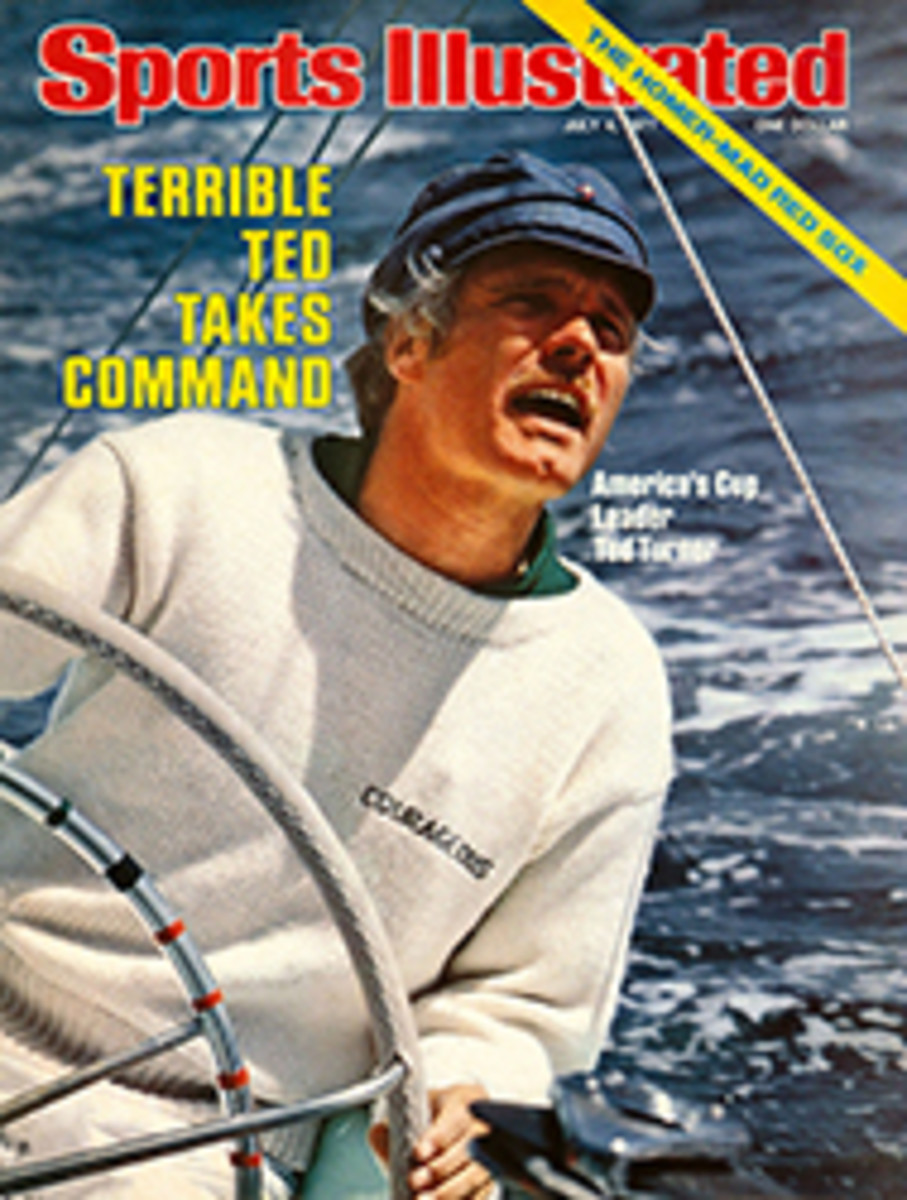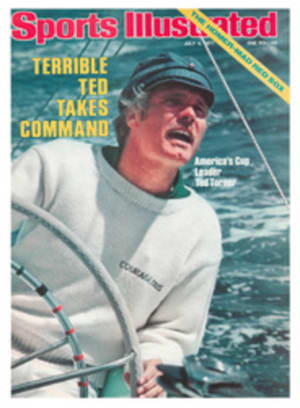
STAGING A BATTLE ROYAL ON THE BRINY
Viewed from aquarter mile away—which is about as close as any spectator gets to them—thebig, handsome 12-meter boats look too dainty and immaculate for the job athand. Battling to windward, they lean together on one tack and then the other,then split and go their separate ways. The sun flashes off the spinning wincharms of one boat as it comes about and, as if cued by that wink of light, herrival wheels over to the opposite tack. As they converge and cross paths andseparate and recross, the motile violence, the clangor and clatter, the screechof steel cables on steel drums are all wasted in the wind, so that from afarthe boats do not seem to be rivals dueling but graceful partners engaged in acourtly dance—provided, of course, that a lower spreader on one of them doesnot buckle suddenly to send the mast and 1,800 square feet of sail kerplunkover the side.
For all theseeming ease, the pressure and tensions are immense on both the machines andthe men who sail them. When a 12-meter is heeled 30 degrees in a hard blow, thetug on its shrouds is about 20 tons, and the total pressure exerted at the footof the mast is nearly twice that. The pressure on the skipper and the tensionin the crew responsible for the $1 million racing baby are obviouslyconsiderable. When a boat is busting through lumpy seas in 25 knots ofwind—taking the bone in her mouth, as they say—she may outfoot a rival, but ifon a single tack the skipper and crew fail to come about smartly enough on anopponent's lee bow, the race can be lost. On the other hand, when skipper andcrew are playing their parts perfectly on the wind and off, even in modest air,an interior tang or some other piece of hardware carefully handcrafted of thebest Swedish steel by a cottage factory in Schmaltz, Switzerland can suddenlypart. When something like that happens—snap, crackle, pop!—over goes the sparand with it the fortunes of the day.
To judge by thePreliminary Trials staged last week off Newport to select the U.S. defender ofthe America's Cup, 12-meter men take the strain somewhat better than theirboats. In the process of winning squeakers and occasionally losing big, thethree skippers and their crews remained sober in purpose but light in heart,while their taut ships showed the temperament and brittleness of highly trainedthoroughbreds.
Not surprisingly,the most ebullient and vociferous of the helmsmen was the leader in thecompetition, Ted Turner. His Courageous, the hull that defended the cup threeyears back, was on her way to winning seven races and losing but one—and thatby only seven seconds, the equivalent of half a length in the KentuckyDerby.
It had beenthought that Courageous would surely be no better than equal to the new12-meters, Lowell North's Enterprise and Ted Hood's Independence. For starters,the new boats were being skippered by men who were not only the world's finestsailmakers but eminent sailors as well; North's reputation as a Star classracer is legend.
Turner,admittedly, is an exceptional ocean racer, acid-tongued and demanding, with aremarkable ability to keep his crews keyed up through days and nights ofcompetition. They are never allowed to become bored or sloppy. Instead ofmutinying at his continual rasping, his crews respect and admire Turner and infact, many of his ocean-racing regulars had been recruited for his America'sCup effort.
As a skipper ofTwelves, however, Turner was suspect. In the 1974 cup trials he had been stuckwith a dud, Mariner, a boat so slow in the preliminary races that her radicalafter sections were cut away and rebuilt on more conventional lines by herdesigner Britton Chance. When Mariner returned in August, Turner was replacedat the helm by Dennis Conner, a notable starter and a fine sailor. Turner wasthen handed Mariner's poor old trial horse, Valiant. Though his boats wereoutclassed, it was also thought that Turner, with all his bellowing, did notconcentrate well enough to be a successful match-racing skipper.
Turner has provedjust the opposite. Some indication came in the Congressional Cup last March, ahead-to-head event that he won. Hood finished fifth and North next to last in ablue-chip field of 10.
In Turner thereis some of the ambidextrous genius of da Vinci as well as the quick wits of analley cat. Tilting against the very best in a secondhand boat—if indeedCourageous may be called that—is an experience Turner can relish. Yet, as hepaced the dock between last week's races, he did not always seem to be hisusual, unusual self. Winning big is not his style. He thrives on squeakers. Heloves to battle with his back against a wall. If there is no wall close by, hewill go miles out of his way to find one. After he beat Hood convincingly byabout a minute in two shortened races of 10 and 11 miles, he was somewhatmoody. When he beat North by 45 seconds in one race, then poked two feet of hisbow across the finish line (the equivalent of a whisker in a horse race) totake another, he was more cheerful. On another day, after he slowly ate away aone-minute 35-second deficit through five legs and lost to North by sevenseconds, and then in the second matchup changed leads with North twice to winby 22 seconds, he was jubilant.
Turner andCourageous duplicated the 1967 Preliminary Trials match-race record of Intrepid(which went on to two successful defenses of the cup). On that occasion thecompetition was notably weaker, because Intrepid's most promising rival, theredesigned Columbia, did not take part. But Turner's foes are far fromconceding the 1977 defense to Courageous.
Although he wononly two races and lost six, Hood remained his usual smiling tacit self, veryhumanly confessing ignorance as to why Independence sometimes moved well andtoo often did not. In a tacking duel on the last windward leg of the first raceof the trials, Hood lost 20 seconds to North on Enterprise. In the last race ofthe trials, in the same sort of soggy, medium-heavy southwest wind, he made upmore than 30 seconds in a similar close duel with Enterprise. How did Hoodexplain the improvement? He shrugged.
Before the serieswas done, the tough seas of one race had knocked the computers, which measurewind speed, direction and boat speed, off the mast of Hood's boat. On anotherbrisk day the halyard hook holding up the mainsail gave way, forcing him tofinish the trials with the head of the main jury-rigged.
But hard-luckhonors ultimately went to North. In the course of eight days one ofEnterprise's jibs was ripped at the seam and another was shredded beyondrepair; a spinnaker shackle failed; several sheets were cut on protrusions; andthe track of the head carriage broke so that Enterprise finished the serieswith her main jury-rigged aloft like Independence's. North's overall record wasfour wins and six losses, and bad luck was not the only factor in the defeats,as North was the first to admit.
If there is onelesson an America's Cup skipper must learn, it is to cover the opposition, thatis to stay between your rival and the next mark in order to control his wind.In the first trial race of this series, North split wide away from Hood onIndependence and, by so doing, turned a 12-second lead into a 34-seconddeficit. When the press asked him why, North said, "Sheer stupidity on mypart. I have a tendency to do that, because in California where the wind issteady, we can get away with it. We had a 10-degree shift on that leg. Wewaited and waited for it to shift back. It did not shift back. I have learnedmy lesson."
In hisexperimental sails, North has used nylon and Dacron and Kevlar, triaxial weavesand unwoven goods—just about everything except hemp sack and wrapping paper.One of his jibs on Enterprise is called the "Blue Max" because it ispale blue. Accustomed to his zest for innovation, the press wanted to know: Isthis blue stuff something new? No, North explained, the man who cut it happenedto favor blue. Another jib was the shade of green commonly used in the Pliofilmtrash containers sold in supermarkets and so is called "the garbagebag." Why green? Because, North explained, somebody donated the material tothe syndicate.
North providedcolor but it was Turner who got the headlines from the start. Before he had wonso much as one leg of a race, he invited his baseball team, the Atlanta Braves,to watch him do his thing on the briny. "If I have to watch them lose, theymight as well see me try to win," he said. By the time the ballplayersarrived, Turner had run up four straight victories, something the Braves hadnot done since late May. A few of the visitors, notably Henry Aaron, who is nowin charge of player personnel, confessed that the tactics of the tall boats hadthem somewhat muddled. When one Brave said the tacking was not clear to him,Turner said, "Tacks are like snow-flakes. They all look alike but every oneis different." Vic Correll, a Brave catcher, had done some sailing whileplaying ball in Latin America, and to prep himself for the 12-meter eventbought a copy of Roger Vaughan's The Grand Gesture, the excellent book-lengthaccount of the futile Manner campaign three years ago. So impressed was Correllthat he started collecting the autographs of 12-meter men in his book.
As if inspired bytheir boss, back home in Atlanta the following night, the Braves won in extrainnings, Turner-style, from the San Diego Padres. Trailing by two in the 10thwith a man aboard, the 21st Brave to go into the game was Correll. He knockedone out of the park to tie the game up. Then with two outs and Jeff Burroughson, Junior Moore hit a double to the fence.
On the water, itwas Turner going for the fences—and reaching them. After this first of threesets of selection trials (the next round begins July 16), Courageous stands7-1, Enterprise 4-6 and Independence 2-6, but the actual difference between theboats is perhaps not so great as those scores suggest. In previous trials,boats that ranked more closely statistically have in fact been more erratic inperformance. In the nip-and-tuck 1974 battle between Courageous and Intrepid,for example, the winning margins, even on shortened courses, exceeded oneminute more often than not. In only five of the 13 races last week was thedifference more than a minute; in six it was less than half a minute.
It is doubtful ifthere has been any earlier series with more honest weather conditions. Theboats were never blown out or fogged out; there were few extravagant windshifts and not so much as half a day of sagging, five-knot air with holes aboat might fall into. It was very steady going, and Turner and Courageous madethe most of it.
TWO PHOTOS
ERIC SCHWEIKARDT
In the only race he lost, Turner (26) ate away a one-minute 35-second deficit to draw almost even with North (27) as they circled the leeward mark and headed for home. Against Hood (28), Turner also lagged, but won after a feisty tacking duel.
TWO PHOTOS
ERIC SCHWEIKARDT
Hood (left) and Turner have skippered cup boats but North (above) is new—and puzzled.

